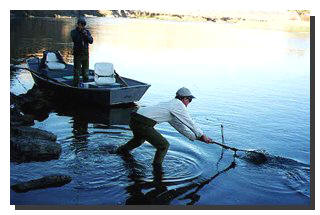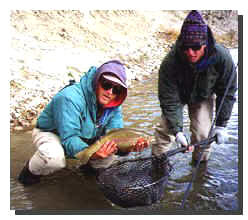A common question among fly fishers is whether it is better to net a trout or not. The short answer is…it depends. The long answer is that you shouldn’t net a trout unless you have to. Having said that, there are times when it is appropriate to use a net.
The basic rule of thumb regarding the handling of trout is don’t. Of course, this is not always practical and we are sometimes forced to net or touch our catch. However, to the extent that it is possible, you want to avoid handling trout, whether with your hands or a net.
One thing you should never do is net a small trout. It’s simply not necessary and is potentially harmful to the trout. While no trout, large or small, should be manhandled, small trout are particularly susceptible to such mistreatment. They are very delicate little creatures. Mishandling small trout can dramatically increase their post-release mortality rate. They may swim away, apparently healthy, but the damage has been done.
particularly susceptible to such mistreatment. They are very delicate little creatures. Mishandling small trout can dramatically increase their post-release mortality rate. They may swim away, apparently healthy, but the damage has been done.
Nets tend to scrape off the protective mucous on a trout’s skin. The mucous allows trout to easily slide through the water, reducing the effort required to get around in its environment. The mucous is also a barrier to bacteria and fungi. To a certain extent, any net will remove some of this mucous leaving the trout susceptible to disease.
The actual fabric of the net is an important factor in minimizing the damage to the trout. Rubber nets, like the one pictured, are the best at reducing the negative impacts of netting a trout, but are really only practical, due to their large size, when boat fishing. Soft knotted cotton nets are acceptable, but not as good as rubber. Being smaller, they are much more practical for wade fishermen, but hard to find. Woven synthetic nets, similar to nylon but softer, are in vogue with leading net manufacturers and are a pretty good compromise. Hard-knotted nylon nets, like you’d find in the Kmart fishing department, are the worst and should not be used, period (assuming you want the trout to survive).
So when is it a good idea to net a trout? When a good size trout is going ballistic and refuses to give up, that’s when! Hard fightin’, hard chargin’, brutes with no quit in their bones are prime candidates for the net. The idea is to reduce the length of the fight thereby reducing the overall amount of stress inflicted. In such cases the use of a net may be justified because you don’t want to play the fish to exhaustion, which can increase post-release mortality rates. Use the net to keep the fight as short as possible.
Proper use of the net can also help minimize its impact. Net the fish, but keep it in the water. Let it catch its breath before lifting for a quick photo. Then return it to the net until it is fully revived. By keeping the netted trout in the water you are helping reduce the friction between the trout’s skin and the net fabric. Lifting the trout from the water while in the net will cause the net fabric to scrape the skin and remove mucous.
revived. By keeping the netted trout in the water you are helping reduce the friction between the trout’s skin and the net fabric. Lifting the trout from the water while in the net will cause the net fabric to scrape the skin and remove mucous.
The bottom line is never net a small trout and only net large trout to reduce the length of the fight.
